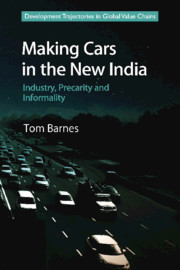Book contents
- Frontmatter
- Dedication
- Contents
- Tables, Figures and Maps
- Acknowledgments
- Abbreviations
- 1 The Limits of Industrialisation
- 2 The Auto Industry in India Today
- 3 Auto Manufacturing and the Evolution of Industrial Policy
- 4 The Transformation of Labour Relations
- 5 Auto Workers in India's National Capital Region
- 6 Work and Life at the Bottom of the Auto Supply Chain
- 7 Driving Down the ‘Low Road’?
- Appendix
- Bibliography
- Index
4 - The Transformation of Labour Relations
Published online by Cambridge University Press: 23 October 2018
- Frontmatter
- Dedication
- Contents
- Tables, Figures and Maps
- Acknowledgments
- Abbreviations
- 1 The Limits of Industrialisation
- 2 The Auto Industry in India Today
- 3 Auto Manufacturing and the Evolution of Industrial Policy
- 4 The Transformation of Labour Relations
- 5 Auto Workers in India's National Capital Region
- 6 Work and Life at the Bottom of the Auto Supply Chain
- 7 Driving Down the ‘Low Road’?
- Appendix
- Bibliography
- Index
Summary
The previous chapter outlined the mutually constitutive role of global Original Equipment Manufacturers (OEMs) and state institutions in the modernisation of Indian auto manufacturing and the industrial transformation of regional economies. Through a process of ‘first-mover coupling’, a minority of foreign and domestic OEMs were able to reap positional advantages by undertaking pioneering investments in the 1980s and 1990s. During this period, India was emerging from an Import Substitution Industrialisation (ISI)-based economic policy framework to a neo-liberal economic policy framework through a gradual process of trade, investment and financial liberalisation.
Firms like Maruti Suzuki India Limited (MSIL) – or Maruti Udyog Limited (MUL) as it was known until the 2000s, Honda and Hero MotoCorp – which operated as the Hero Honda joint venture from 1984–2010, Tata Motors and Hyundai Motor India Limited (HMIL) played critical roles in modernising local industry by establishing their global production networks in key regions. These firms were rewarded with dominant shares in their respective vehicle markets and, for MSIL, Hero, and HMIL, with the capacity to pursue the preferred firm-level and network strategies of their global parent companies.
Along with the capacity to reshape commercial relations with networks of components manufacturers and vendors on a regional level, these pioneering firms were also in a position to strongly influence practices of employment relations and norms in Indian manufacturing. One of the key features of labour standards and employment relations in Indian auto manufacturing is its transformation in the hands of these firms and their key suppliers via tension and conflict with state institutions, key competitors and employees.
Yet the liberalisation of trade and investment in domestic auto manufacturing has also reflexively challenged the capacity of these pioneering firms to shape employment relations as they originally intended. As this chapter will demonstrate, this led to dramatic changes in the social regulation of employment relations which began in the early 2000s, and have continued to reverberate over the last 15 years.
- Type
- Chapter
- Information
- Making Cars in the New IndiaIndustry, Precarity and Informality, pp. 105 - 135Publisher: Cambridge University PressPrint publication year: 2018

